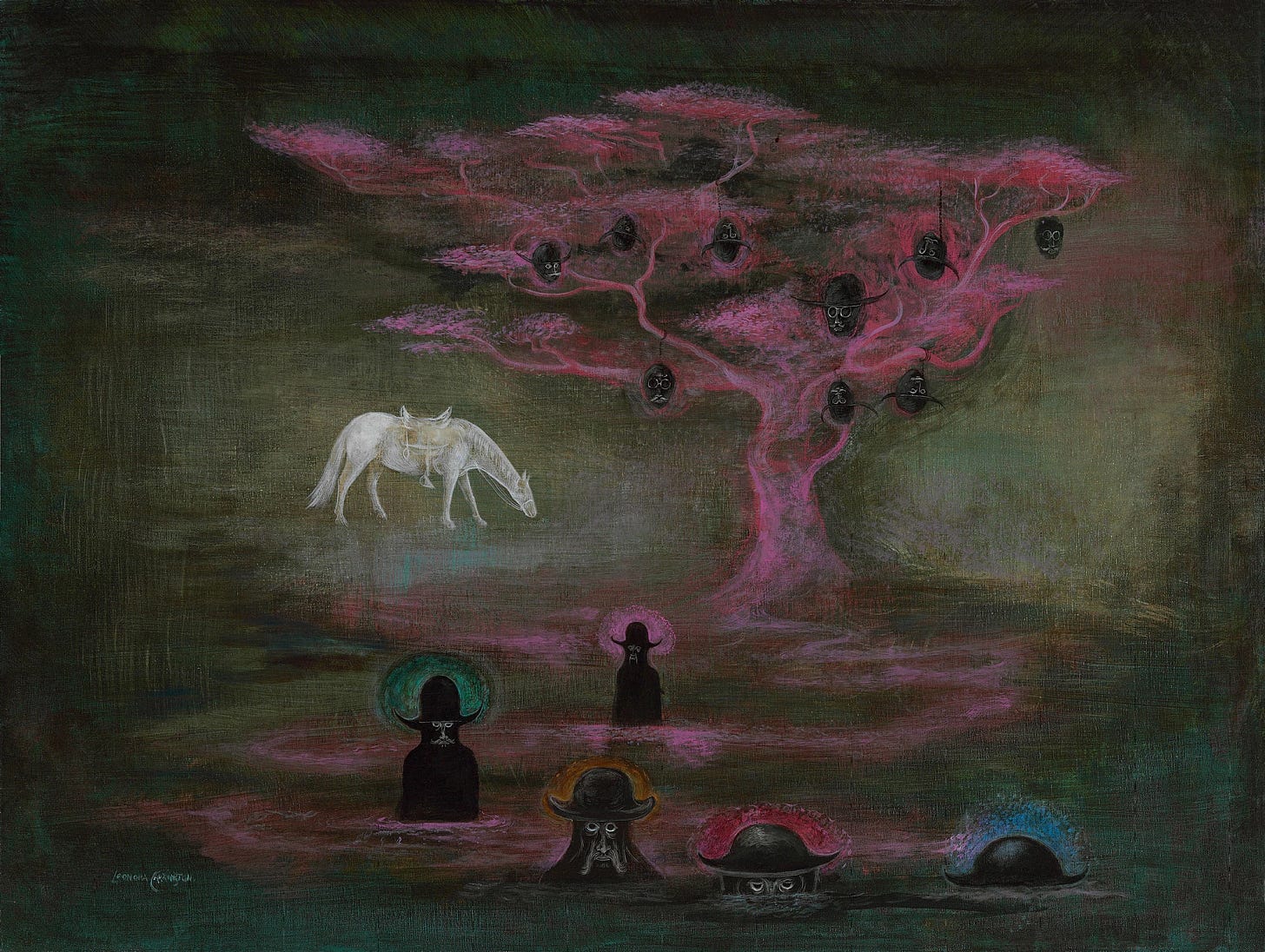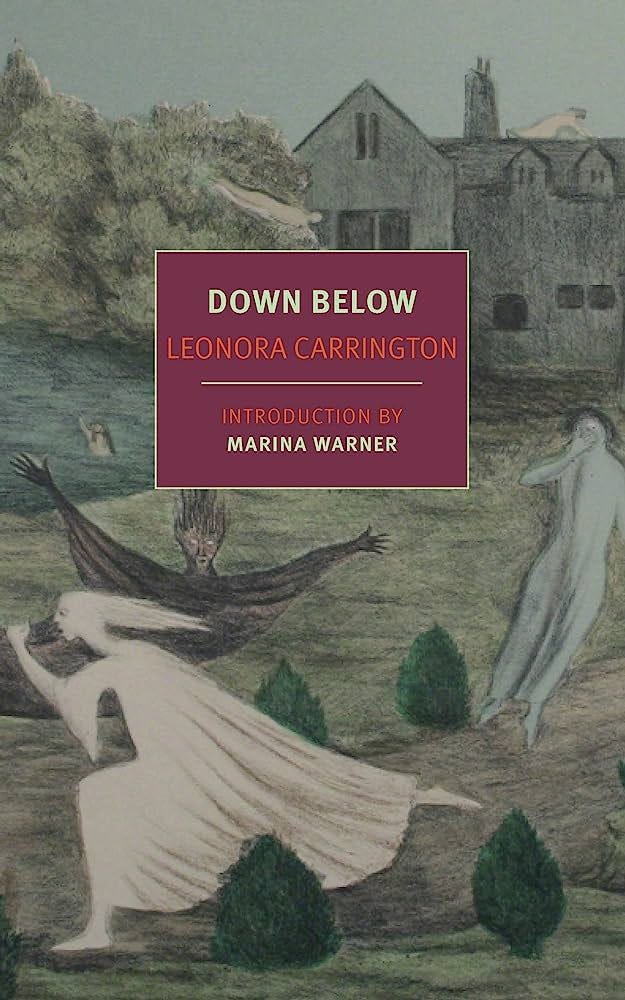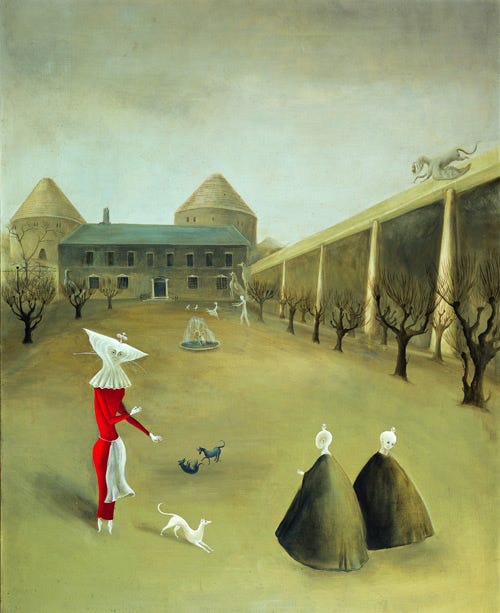Art has the power to evoke deep emotions, capturing the complexities of the human experience. Leonora Carrington, a prominent surrealist painter and writer, employed her artistic talents to explore various themes, including the profound concept of loneliness. Through her works, Carrington delved into the depths of solitude, using vivid imagery and symbolic elements to convey the isolation and yearning that pervades the human condition. This essay will examine the theme of loneliness in the art of Leonora Carrington, exploring how her works convey a sense of isolation, longing, and the search for connection.
Carrington's surrealist art often incorporates dreamlike and fantastical imagery, creating a sense of otherworldliness that amplifies the theme of loneliness. Her paintings feature solitary figures inhabiting strange and mystical landscapes, emphasizing the individual's separation from their surroundings. Through these images, Carrington captures the inherent loneliness experienced by individuals as they navigate unfamiliar and isolated environments.
Loneliness in Carrington's work is often symbolized by elements such as disconnected body parts, empty spaces, and desolate landscapes. The fragmented bodies and detached limbs depicted in her paintings serve as metaphors for the fragmented sense of self and disconnection from others. The absence of companionship is emphasized by the vast empty spaces, reinforcing the profound sense of isolation experienced by her subjects.
Carrington's exploration of identity within the context of loneliness is another recurring theme in her work. Her paintings often depict women as central figures, isolated and searching for their place in a world that seems distant and alienating. Through her art, Carrington confronts the complexities of female identity and the challenges women face in finding authentic connections amidst societal expectations and constraints. This examination of identity reinforces the profound sense of loneliness experienced by her subjects.
The psychological dimensions of loneliness are also explored in Carrington's work. She delves into the internal struggles, fears, and anxieties that accompany feelings of isolation. Her surrealist compositions are filled with symbolic references to psychological states, such as the depiction of psychological landscapes or the presence of surreal creatures representing inner turmoil. These elements further emphasize the profound emotional isolation experienced by her subjects, revealing the depth of their inner loneliness.
Amidst the pervasive theme of loneliness, Carrington's work also conveys a strong longing for connection. Her subjects often exhibit a yearning for human connection, reaching out toward one another or seeking companionship with mystical creatures. This longing reveals the universal human desire to overcome isolation and find solace in the presence of others.
Leonora Carrington's art delves deep into the theme of loneliness, skillfully capturing the complexities and profound emotions associated with this universal human experience. Through her use of surrealist imagery, symbolism, and exploration of identity, Carrington communicates a sense of isolation, longing, and the search for connection. Her works evoke a visceral response in viewers, inviting them to contemplate their own experiences of loneliness and recognize the shared nature of this profound emotion. Carrington's art serves as a poignant reminder of the human need for companionship and the enduring quest for meaningful connections in a world that often feels distant and isolating.
Reading the Surreal.
Loneliness is a universal human experience that has been explored and depicted in various forms of art throughout history. In the realm of literature, few authors have delved into the depths of loneliness as uniquely and imaginatively as Leonora Carrington. As a prominent Surrealist artist and writer, Carrington's novels delve into the complexities of solitude, often through fantastical and surreal worlds. This essay explores Carrington's novels and how they illuminate the theme of loneliness, inviting readers to explore the profound emotional landscapes of her characters.
In Carrington's novels, such as "The Hearing Trumpet" and "The Stone Door," loneliness serves as a sitimulent for existential introspection. The characters embark on journeys, both physical and metaphorical, in search of connection and self-discovery. Loneliness becomes a driving force that propels the protagonists into alternative realms where they encounter bizarre and otherworldly experiences. Through these imaginative narratives, Carrington suggests that loneliness can be transformative, leading individuals to confront their fears, desires, and innermost selves.
Carrington's novels often feature characters who seek refuge from their lonely existence by entering surreal and dreamlike realms. In "The Hearing Trumpet," the elderly protagonist, Marian Leatherby, finds solace in an unconventional retirement home where she uncovers a secret society and embarks on a journey filled with mysticism and magic. These fantastical elements provide a counterbalance to the isolation and monotony of everyday life, offering readers a glimpse into the possibilities of escape from loneliness.
While loneliness is often depicted as a personal, individual experience, Carrington's novels also explore the metaphorical aspects of isolation. Through her use of symbolism and allegory, she portrays societal and cultural loneliness. In "The Stone Door," for instance, the protagonist confronts a world that rejects her individuality and attempts to conform her to societal expectations. This metaphorical loneliness underscores Carrington's critique of rigid societal norms and the alienation experienced by those who don't conform.
Interestingly, Carrington's novels also offer a different perspective on loneliness—one that suggests the possibility of embracing solitude. Rather than viewing loneliness as solely negative, she presents it as a catalyst for personal growth and introspection. Her characters often find empowerment and liberation through their solitary journeys, discovering hidden strengths and a newfound sense of self. Carrington suggests that loneliness can be a transformative state, one that allows individuals to delve deeper into their own psyche and emerge with a stronger sense of identity.
Leonora Carrington's novels offer a unique exploration of loneliness through the lens of surrealism and fantasy. Her imaginative narratives and rich symbolism create a fertile ground for readers to contemplate the complexities of isolation and its transformative potential. By delving into the depths of loneliness, Carrington invites us to reflect on our own experiences of solitude and recognize the profound emotions and revelations that can arise from such introspection. Through her novels, Carrington reminds us that loneliness, though often daunting, can be a catalyst for personal growth and a gateway to self-discovery.
Leonora Carrington was a British-born artist and writer who gained prominence as one of the key figures of the Surrealist movement. Her unique and imaginative works, infused with symbolism and mythology, continue to captivate audiences worldwide. Carrington's life was as extraordinary as her art, marked by personal struggles, creative exploration, and a fierce determination to break societal norms. This biography delves into the life and legacy of Leonora Carrington, shedding light on her artistic genius and the profound impact she had on the art world.
Leonora Carrington was born on April 6, 1917, in Clayton Green, Lancashire, England, to an affluent family. From a young age, she exhibited a rebellious spirit and a keen interest in art and literature. Encouraged by her parents, she received a formal education in painting and attended the Chelsea School of Art in London. It was during this time that she encountered the Surrealist movement, which would shape the trajectory of her artistic career.
In the 1930s, Carrington became deeply involved with the Surrealist movement, connecting with artists such as Max Ernst, René Magritte, and Salvador Dalí. Her distinctive style emerged, blending elements of fantasy, mythology, and the occult. Carrington's works often depicted fantastical creatures, hybrid beings, and mystical landscapes, reflecting her fascination with Celtic mythology, alchemy, and the occult.
With the outbreak of World War II, Carrington's life took an unexpected turn. Fleeing from the turmoil of Europe, she found herself in Mexico City in 1942. Mexico became her new home, and she embraced the country's rich cultural heritage, drawing inspiration from indigenous art and mythology. Carrington's work began to incorporate Mexican symbols, mysticism, and the vibrant colors of the country, further enriching her artistic vision.
Apart from her visual art, Leonora Carrington made significant contributions to literature. She wrote several short stories and novels, blending elements of fantasy, surrealism, and autobiography. Her writing often explored themes of transformation, identity, and the inner world of the subconscious. Carrington collaborated with various literary figures, including Mexican poet and diplomat Octavio Paz, further expanding her creative horizons.
While Carrington's artistic career flourished, her personal life was marked by hardships. She faced emotional turmoil, struggled with mental health issues, and dealt with the loss of loved ones. Nevertheless, Carrington's resilience and determination allowed her to persist in her artistic pursuits. Her resilience is perhaps most evident in her participation in the Women's Liberation Movement in Mexico, fighting for gender equality and paving the way for future generations of female artists.
Leonora Carrington's art continues to captivate and inspire audiences worldwide. Her unique vision and contributions to Surrealism have cemented her status as one of the movement's most prominent female artists. Her work has been exhibited in prestigious galleries and museums, including the Tate Modern in London and the Museum of Modern Art in Mexico City. Carrington's legacy extends beyond her art; she is seen as a pioneer for women in the art world and a symbol of creative freedom and individuality.
Leonora Carrington's life and art are a testament to the power of imagination and the resilience of the human spirit. Through her visionary works, she transported viewers to surreal and mythical realms, challenging conventional norms and expanding the possibilities of artistic expression. Leonora Carrington's contributions to art and literature continue to inspire generations of artists and stand as a testament to the transformative power of the creative mind.
Hi, thank you so much for reading. Sorry it may not be up to my usual standards, having to work on my phone to write as my laptop is dead!! Fancy buying me a coffee?That would be so awesome if you could and would help my work towards a new laptop.












She’s amazing isn’t she! Oh I like the Blake and Bosch comparison, nice.
You’re so welcome, thank you for reading.
I had never heard of this artist until now and wow - great find. You really nailed the line between informative and fascinating. Excellent stuff!